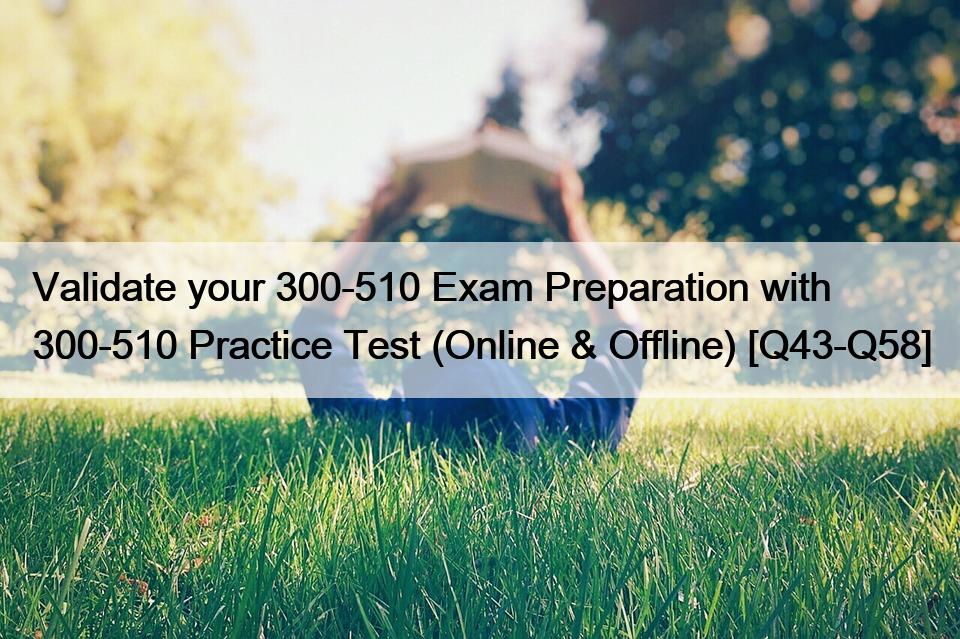Validate your 300-510 Exam Preparation with 300-510 Practice Test (Online & Offline)
Get all the Information About Cisco 300-510 Exam 2022 Practice Test Questions
What is the duration, language, and format of Implementing Cisco Service Provider Advanced Routing Solutions (300-510 SPRI) Exam
- Duration of Exam: 90 minutes
- Validity: 3 years
- Language of Exam: English
- Format: Multiple choice
For more info read reference:
Topics of Implementing Cisco Service Provider Advanced Routing Solutions (300-510 SPRI) Exam
These core topics of 310-510 SPRI practice test listed below are general recommendations for the material that is likely to be used for the examination. However, on any delivery of the test, other similar topics could also appear. The guidelines below can update at any time without notice to better represent the contents of the 310-510 SPRI exam dumps pdf and for clarity purposes.
It is recommended that, where possible, the applicant use these courses and/or other resources to provide background information on the exam objectives. The syllabus for the Implementing Cisco Service Provider Advanced Routing Solutions (300-510 SPRI) examination is listed below in detail for each section of 300-510 SPRI exam dumps:
- Implement and verify MPLS
- Implement Multiarea IS-IS
- Influencing Border Gateway Protocol Route Selection
- Implement BGP security options
- Implement BGP Security Options
- Implement Cisco MPLS TE
- Implementing PIM-SM Protocol
- Describe and compare core multicast concepts
- Improving BGP Convergence and Implementing Advanced Operations
- Troubleshooting Routing Protocols
- Describe how traffic engineering is used in segment routing networks
- Implement and troubleshoot MPLS traffic engineering
- Scaling BGP in Service Provider Networks
- Implement Rendezvous Point Distribution
- Implementing Segment Routing
- Implement BGP Route Reflectors
- Introducing Routing Protocol Tools, Route Maps, and Routing Policy Language
- Implementing and Verifying MPLS
- Deploying IPv6 Tunneling Mechanisms
- Implement and verifying the PIM-SM protocol
- Implement advanced features to improve convergence in BGP networks
- Implement mechanisms for dynamic Rendezvous Point (RP) distribution
- Describing Segment Routing Traffic Engineering (SR-TE)
- Implementing Route Redistribution
- Configure and Verify Interior Gateway Protocol (IGP) Segment Routing
- Implement MPLS in the Service Provider Core
- Securing BGP in Service Provider Networks
- Implement OSPF Special Area Types (IPv4 and IPv6)
- Implementing Interdomain IP Multicast
- Implement Route Redistribution
- Troubleshoot OSPF, ISIS, and BGP
- Implement Tunnels for IPv6
- Implement PIM-SM Enhancements
- Influence BGP Route Selection
- Implementing PIM-SM Enhancements
- Implement enhanced Protocol-Independent Multicast – Sparse Mode (PIM-SM) features
- Enable and Optimize PIM-SM
- Implement Multicast Source Discovery Protocol (MSDP) in the interdomain environment
- Implement IPv6 tunneling mechanisms
- Implement and verify segment routing technology within an interior gateway protocol
- Implementing IP Multicast Concepts and Technologies
- Implementing and Verifying Open Shortest Path First Multiarea Networks
Check Real Cisco 300-510 Exam Question for Free (2022): https://www.validbraindumps.com/300-510-exam-prep.html






